Welcome to my guide on how to make the most out of your pool this season with thermal blanket pool covers. As a pool owner myself, I know firsthand the struggle of maintaining warm water temperatures and managing energy costs. That’s why I’m excited to share my tips and tricks on how to use thermal blanket pool covers to maximize pool warmth and minimize your expenses.

Thermal blanket pool covers are a simple and effective way to retain heat and reduce energy costs. By covering your pool when not in use, you can prevent heat loss and maintain warm water temperatures all season long. Additionally, using a pool cover can help reduce water evaporation and minimize chemical usage.
- Thermal blanket pool covers retain heat and reduce energy costs
- Covering your pool when not in use can prevent heat loss and maintain warm water temperatures
- Using a pool cover can help reduce water evaporation and minimize chemical usage
Understanding Thermal Blanket Pool Covers
Thermal blanket pool covers are an ideal solution for retaining heat and conserving energy in swimming pools. They act as insulation, preventing heat loss and keeping the water warm for longer periods of time. In addition to their energy-saving benefits, they also provide a safer swimming environment by preventing accidental falls into the pool.
There are several types of pool covers on the market, including manual and automatic covers. Manual covers are typically less expensive and easy to install, but require manual removal and replacement. Automatic covers, on the other hand, are more expensive but offer convenience and can be operated with the push of a button or a remote control.
| Type of pool cover | Pros | Cons |
|---|---|---|
| Manual cover | Less expensive, easy to install | Requires manual removal and replacement |
| Automatic cover | Convenient, can be operated with the push of a button or remote control | More expensive |
No matter which type of pool cover you choose, it is important to select one that is the appropriate size for your pool and made of quality materials. A well-made pool cover should be durable, long-lasting, and resist UV damage.
Benefits of Using Energy-Saving Pool Covers
Energy-saving pool covers offer a wide range of benefits for pool owners looking to save money on utility costs while still enjoying warm swims all season long. Here are some of the key benefits of using energy-saving pool covers:
| Benefit | Explanation |
|---|---|
| Minimizes heat loss | Energy-saving pool covers act as insulation for the pool, preventing heat loss and keeping the water warm. |
| Extends swimming season | By retaining heat, pool covers can extend the swimming season, allowing for earlier openings and later closings. |
| Reduces need for pool heating systems | By keeping the water warm, pool covers can significantly reduce the need for pool heating systems, ultimately saving energy and reducing utility costs. |
| Prevents evaporation | Covering the pool when not in use can prevent evaporation, leading to significant water and chemical savings. |
Overall, energy-saving pool covers are an excellent investment for pool owners looking to save money while still maintaining optimal water temperature and quality.
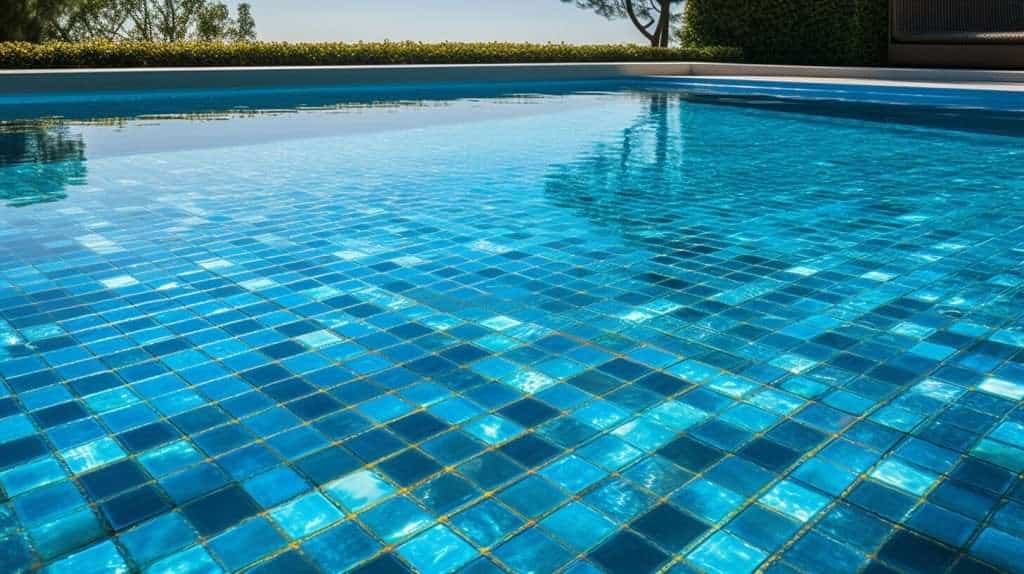
Choosing the Right Swimming Pool Thermal Blankets
When selecting a thermal blanket for your swimming pool, there are several factors to consider. Size is an essential consideration, as the cover should fit snugly over the pool surface to maximize heat retention. Additionally, you should choose a high-quality material, such as UV-resistant polyethylene, to ensure durability and long-lasting performance.
Another crucial factor is thickness, as a thicker blanket can provide more effective insulation. However, thicker blankets may also be more challenging to handle and store, so you should strike a balance between insulation and manageability.
Lastly, consider the color of the blanket. Darker covers will absorb more heat than lighter ones, so if you live in a cooler climate, a darker cover may be more beneficial in retaining heat.

Investing in a high-quality thermal blanket pool cover can help maximize pool warmth, reduce energy costs, and provide warm swims all season long. Ensure you choose a reputable manufacturer and prioritize durability and lifespan when making your purchase.
How Pool Covers Control Temperature
One of the key benefits of using a pool cover is temperature control. Pool covers help maintain the desired temperature of the water by preventing heat loss. During the day, the cover traps heat from the sun and prevents it from escaping into the air. At night, the cover acts as insulation, preventing heat loss to the cooler air temperatures.
By covering the pool when not in use, you can ensure that the water temperature stays optimal for your swimming experience. This is especially important during the cooler months when the water temperature tends to drop more quickly. In addition to retaining heat, pool covers also minimize the effects of wind and reduce water evaporation.
When using a pool cover for temperature control, it’s important to cover the pool as soon as you’re done swimming. The longer you wait, the more heat will be lost from the water. It’s also important to invest in a high-quality cover that is specifically designed for temperature control. This ensures maximum heat retention and energy efficiency.

Enhancing Energy Efficiency with Pool Covers
As I mentioned earlier, using pool covers can enhance energy efficiency and save you money on utility costs. By significantly reducing heat loss, pool covers help reduce the need for constant heating, which can consume significant energy. In addition, they can also help minimize chemical usage and conserve water by preventing evaporation.
One important way pool covers enhance energy efficiency is by preventing heat loss during cooler nights. During colder weather, a significant amount of heat can escape from an uncovered pool. However, a high-quality pool cover can act as insulation, keeping the heat inside and maintaining optimal water temperatures.
On the other hand, pool covers can also retain heat during the day by capturing the sun’s rays and transferring the heat to the water. This means your pool can stay warm and comfortable even without an external heating system, allowing you to extend your swimming season and save money on energy costs.
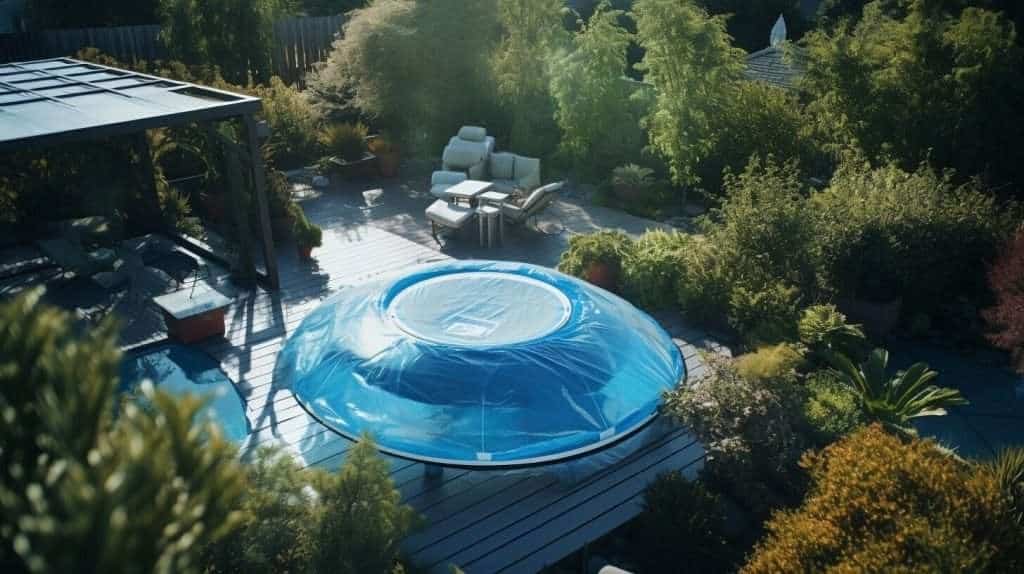
When selecting a pool cover for energy efficiency, it’s important to choose a high-quality cover that is designed for this purpose. Look for covers that offer excellent insulation and are durable enough to withstand long-term use. You can also consider investing in a thicker cover or combining multiple insulation methods for maximum energy efficiency.
Reducing Evaporation with Pool Covers
As a pool owner, reducing evaporation is a key concern. Evaporation leads to water loss, increased chemical usage, and the need for frequent refilling. However, with the use of a pool cover, you can significantly reduce evaporation and save both water and money in the long run.
When left uncovered, a pool loses water due to a combination of factors such as wind, heat, and humidity. In fact, it’s estimated that an average-sized pool can lose up to 1 inch of water per week due to evaporation alone.
By covering your pool when not in use, you can dramatically reduce evaporation. A thermal blanket pool cover is especially effective at preventing water loss and retaining heat. It acts as insulation, trapping heat and preventing it from escaping, while also reducing the amount of water lost due to evaporation.
Not only does this help to reduce water usage and chemical costs, but it also helps to conserve energy by minimizing the need for pool heating systems to maintain the desired water temperature.
Investing in a high-quality pool cover is an easy and effective way to reduce evaporation and keep your pool water levels consistent throughout the season.
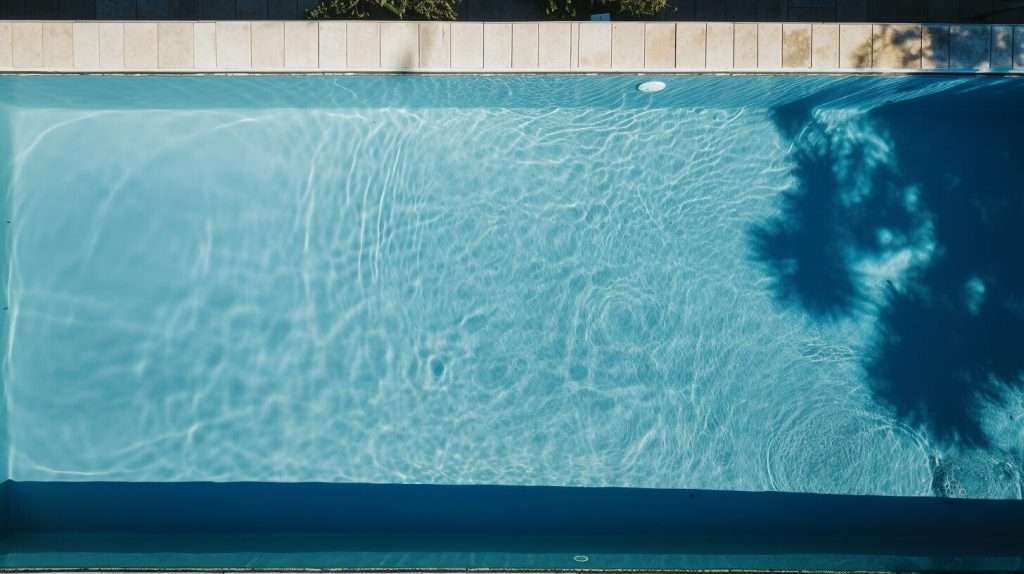
Maintaining and Cleaning Pool Covers
Proper maintenance and cleaning of pool covers are essential to ensure optimal performance and prolong their lifespan. Regular maintenance can help prevent damage and ensure proper insulation, while cleaning can remove debris and prevent the growth of mold and mildew.
To maintain your pool cover, start by inspecting it periodically for wear and tear, such as holes or tears. Address any damages immediately to prevent further deterioration. Also, ensure that the cover is properly aligned and securely fastened to the pool to prevent it from lifting off or becoming dislodged.
To clean your pool cover, remove any debris, such as leaves or dirt, using a soft-bristled brush or a leaf blower. Avoid using harsh chemicals or abrasive materials that may damage the cover. If the cover is stained or has mold or mildew, use a mild detergent or a specialized pool cover cleaner to remove the stains.
After cleaning, allow the cover to dry completely before storing it. This will prevent the growth of mold and mildew and ensure that it is ready for use when you need it. Store the cover in a cool, dry place, away from direct sunlight and moisture.

Additional Tips for Pool Temperature Control
Controlling pool temperature is not just about pool covers, and there are other ways to enhance the warmth of your swimming pool. One of the most effective ways to improve pool temperature control is to insulate the pool. Insulating the pool involves minimizing heat loss and retaining warmth, which ultimately reduces energy consumption and saves money on utility bills.
Tip #1: Besides using thermal blankets, insulating the pool involves installing insulation materials such as foam boards or spray foam. These materials help create a thermal barrier and prevent heat loss. Be sure to consult with a professional to determine the best insulation method for your pool.
Tip #2: Another way to improve pool temperature control is to install a solar pool heater. Solar heaters use the sun’s energy to heat the water, reducing the need for electricity or gas-powered heating systems. Additionally, solar heaters are environmentally friendly and can save you money on energy costs in the long run.
Tip #3: You can also use a pool enclosure to keep the water warm. Enclosures can come in various forms, such as retractable or stationary. They help retain heat, protect the pool from debris, and extend the swimming season.
Tip #4: Lastly, consider using a pool-surface coating to help retain heat. Pool coatings can come in different colors and materials, and they help absorb solar energy. Coatings can also extend the life of your pool, improve resistance to chemicals, and reduce water evaporation.
By following these additional tips for pool temperature control, you can further enhance the warmth of your swimming pool. Implementing these tips, combined with using a thermal blanket pool cover, can help you extend your swimming season and save money on energy costs. One way to improve pool temperature control is to use a solar cover, also known as a pool thermal blanket. This cover helps to trap heat from the sun, keeping the water warm and reducing the amount of energy required to maintain the temperature. Additionally, using a pool thermal blanket can help to prevent evaporation, which can also lead to heat loss.
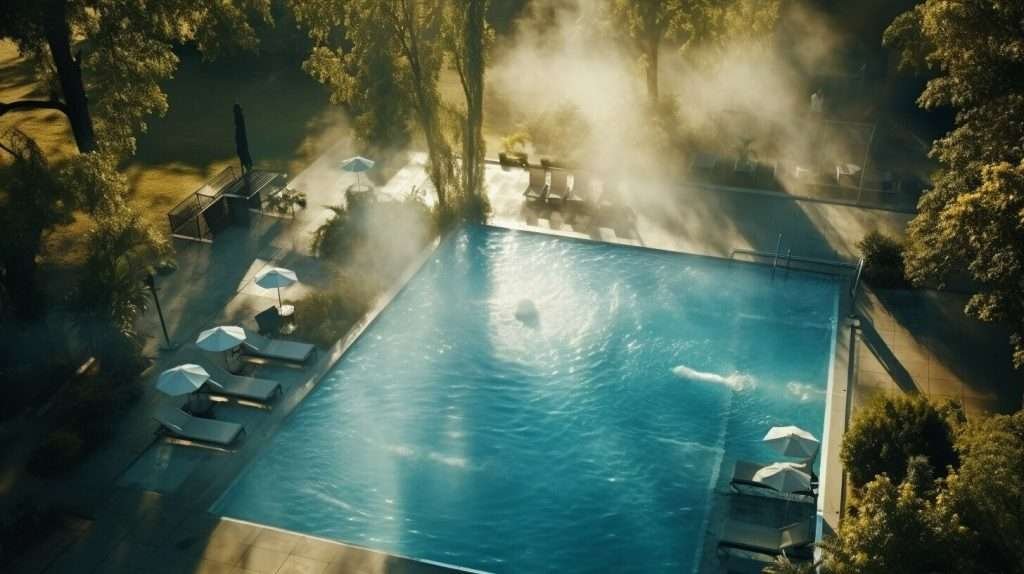
Investing in a Thermal Blanket Pool Cover
Investing in a thermal blanket pool cover is a wise decision for any pool owner looking to save money while extending their swimming season. Not only does it maximize pool warmth and reduce energy costs, but it also provides a host of other benefits.
| Benefits | Description |
|---|---|
| Energy savings | By minimizing heat loss, pool covers significantly reduce energy costs and the need for pool heating systems. |
| Extended swimming season | With a pool cover, you can enjoy warm swims for a longer period of time, even in cooler weather. |
| Water conservation | Pool covers prevent evaporation and minimize water loss, saving water and reducing the need for constant refilling. |
When investing in a thermal blanket pool cover, it’s important to choose a high-quality cover from a reputable manufacturer. Look for durable, UV-resistant materials that will provide long-lasting performance. Consider factors such as size, thickness, and other features that will meet your specific needs.
By choosing the right pool cover and properly maintaining it, you’ll be able to maximize the benefits of your investment and enjoy a warm and energy-efficient swimming pool for years to come.
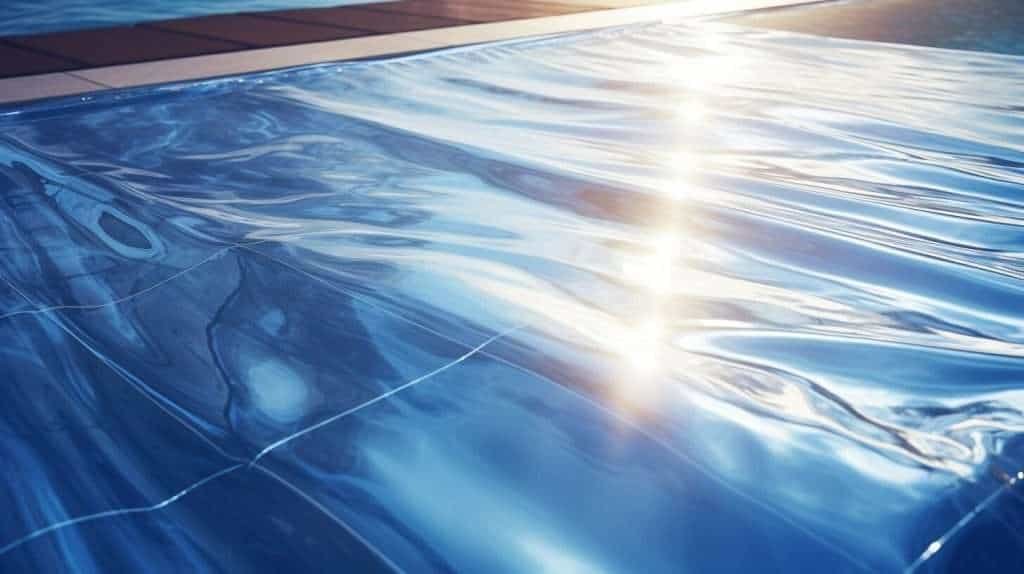
Conclusion
In conclusion, investing in a thermal blanket pool cover is an excellent choice for maximizing pool warmth and energy savings. By retaining heat and reducing evaporation, these covers provide a cost-effective solution for maintaining optimal pool temperature all season long. It is important to choose the right size and material for your pool, and to maintain and clean the cover regularly for long-lasting performance. Additionally, implementing other insulation methods can further enhance pool temperature control. Overall, a quality thermal blanket pool cover is a smart investment that will provide long-term savings and increased enjoyment of your pool.How Can I Maximize Pool Warmth with a Thermal Blanket?
Using a pool thermal blanket is an easy and effective way to maximize pool warmth. Designed to retain heat, these blankets reduce evaporation and heat loss, keeping your pool water warmer for longer periods. By covering your pool with a thermal blanket when not in use, you can significantly reduce energy costs and extend your swimming season.
FAQ
Q: How do thermal blanket pools maximize pool warmth?
A: Thermal blanket pools maximize pool warmth by retaining heat, reducing energy costs, and providing warm swims all season long.
Q: What are thermal blanket pool covers?
A: Thermal blanket pool covers act as insulation for the pool, retaining heat and preventing heat loss. They come in different types with various features.
Q: What are the benefits of using energy-saving pool covers?
A: Energy-saving pool covers significantly reduce energy costs, extend the swimming season, and minimize the need for pool heating systems.
Q: How do I choose the right swimming pool thermal blanket?
A: When choosing a swimming pool thermal blanket, consider factors such as size, material, thickness, and UV resistance. Opt for a durable blanket for long-lasting performance.
Q: How do pool covers control temperature?
A: Pool covers prevent heat loss during cooler nights and retain heat during the day, regulating the temperature of the pool water. It is important to cover the pool when not in use.
Q: How do pool covers enhance energy efficiency?
A: Pool covers reduce the need for pool heating systems, saving energy and reducing utility costs. They also prevent evaporation, leading to significant water and chemical savings.
Q: How do pool covers reduce evaporation?
A: Pool covers reduce evaporation by covering the pool when not in use, preventing water loss and the need for constant refilling. This conserves water and reduces chemical usage.
Q: How do I maintain and clean pool covers?
A: Regular maintenance and proper cleaning techniques can prolong the life of pool covers and ensure optimal performance. Follow recommended guidelines for maintenance and storage.
Q: What are additional tips for pool temperature control?
A: For effective pool temperature control, consider pool insulation methods such as using thermal blankets in combination with other techniques. Optimize pool temperature based on different seasons.
Q: What is the investment value of a thermal blanket pool cover?
A: Investing in a high-quality thermal blanket pool cover offers long-term savings on energy costs and extends the swimming season. Choose a reputable manufacturer for optimal results.


